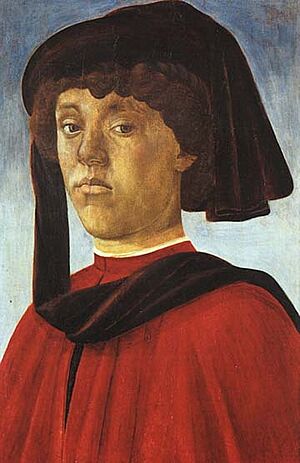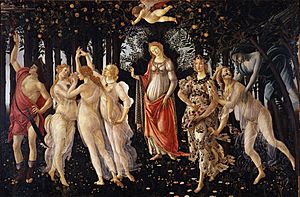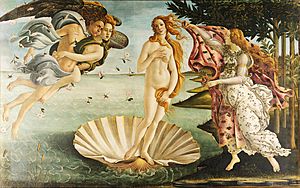Lorenzo di Pierfrancesco de' Medici facts for kids
Quick facts for kids
Lorenzo di Pierfrancesco de' Medici
|
|
|---|---|

Possible portrait of Lorenzo, by Sandro Botticelli
|
|
| Born | 4 August 1463 Florence, Republic of Florence |
| Died | 20 May 1503 (aged 39) Florence, Republic of Florence |
| Noble family | Medici |
| Spouse(s) |
Semiramide Appiano
(m. 1482) |
| Issue | Pierfrancesco the Younger Averardo de' Medici Laudomia de' Medici Ginevra de' Medici Vincenzo de' Medici |
| Father | Pierfrancesco the Elder |
| Mother | Laudomia Acciaioli |
Lorenzo di Pierfrancesco de' Medici (born August 4, 1463 – died May 20, 1503) was an important Italian banker and politician. People often called him the Popolano, which means "of the people." He was the brother of Giovanni il Popolano. Lorenzo belonged to a younger part of the famous House of Medici family in Florence.
Early Life and Education
Lorenzo was born in Florence. His father was Pierfrancesco de' Medici (the Elder), and his mother was Laudomia Acciaioli. The two main parts of the Medici family often had disagreements. Lorenzo's father tried to keep his sons away from the influence of the main family branch.
However, Lorenzo and his brother Giovanni were still young boys when their father died in 1476. After this, their older cousin, Lorenzo (known as il Magnifico), became their guardian. Il Magnifico was the powerful ruler of Florence at the time. He faced money problems after 1478 and used some of the boys' inheritance through special "forced loans." By the time Lorenzo and Giovanni became adults, they believed il Magnifico owed them a lot of money. He did pay back some of it in 1485.
Even with these money issues, Lorenzo il Magnifico made sure young Lorenzo got the best education available. Lorenzo di Pierfrancesco studied with famous thinkers of the Renaissance like Marsilio Ficino and Angelo Poliziano. He also studied with Giorgio Antonio Vespucci, who was the uncle of the famous explorer Amerigo Vespucci. Amerigo was a fellow student and later became a friend and employee of Lorenzo. Amerigo Vespucci sent many of his famous letters about the "New World" to Lorenzo di Pierfrancesco.
Lorenzo di Pierfrancesco became known as a person with modern ideas. He was also a poet and someone who really understood art. Around 1485, he asked for a special handwritten book of Dante's Divine Comedy that included beautiful artwork by Botticelli.
Family and Art Patronage
In 1482, Lorenzo il Magnifico arranged for Lorenzo di Pierfrancesco to marry Semiramide d'Appiani. She was the daughter of a lord named Jacopo III from Piombino. This marriage brought good business deals and important political connections for Lorenzo.
It is thought that Lorenzo il Magnifico might have asked Sandro Botticelli to paint Pallas Athene Taming a Centaur as a wedding gift for the couple. This painting might have suggested that Semiramide (shown as Pallas) should help guide young Lorenzo (shown as the centaur). It is also believed that Botticelli's Allegory of Spring was painted to celebrate this wedding. Later, Lorenzo di Pierfrancesco is thought to have asked Botticelli to paint The Birth of Venus, which is one of the most famous paintings from the Renaissance.
Lorenzo di Pierfrancesco owned two important family homes: the Villa del Trebbio, which he got from his grandfather, and the Villa di Castello, which he bought in 1477. In 1483, he was sent as Florence's official representative, an ambassador, to Paris. There, he attended the crowning of Charles VIII of France.
Political Life
Disagreements about the family inheritance continued. The biggest problem with Lorenzo il Magnifico happened in 1484. Il Magnifico made sure Lorenzo di Pierfrancesco's name was removed from the lists of people who could be chosen for political jobs in Florence. As part of a deal in 1485, Lorenzo di Pierfrancesco and his brother Giovanni received the Medici family property of Villa Cafaggiolo. It became clear that Lorenzo di Pierfrancesco would not be able to hold any public office or have political goals while il Magnifico was in charge.
When Lorenzo il Magnifico died in 1492, Lorenzo and Giovanni did not support il Magnifico's son, Piero (il Fatuo). Two years later, they were sent away from Florence. But they came back when King Charles VIII of France invaded Italy and Piero was removed from power by a new government that supported the people. The two brothers joined this new government and were given the nickname Popolano, meaning "of the people." Lorenzo di Pierfrancesco became a very important person in this new government. Many people saw him as the person who would continue il Magnifico's support for culture and arts. He supported artists like Botticelli, Michelangelo, Filippino Lippi, and Bartolomeo Scala. In 1494, he started a workshop for making pottery in Cafaggiolo.
Lorenzo was less famous than Savonarola, a powerful religious leader at the time. But after Savonarola's death, some people thought Lorenzo would become the main ruler of Florence. However, he did not want this role. In 1501, Lorenzo di Pierfrancesco was suspected of working with Cesare Borgia to help Borgia take over the city, but these accusations were never proven. Lorenzo died in Florence in 1503.
His grandson Lorenzino de' Medici played a role in the end of the "senior" Medici branch's rule in Florence. This meant that power then went to Lorenzo's great-grandson Cosimo I de' Medici.
Images for kids
See also
 In Spanish: Lorenzo de Pierfrancesco de Médici para niños
In Spanish: Lorenzo de Pierfrancesco de Médici para niños





